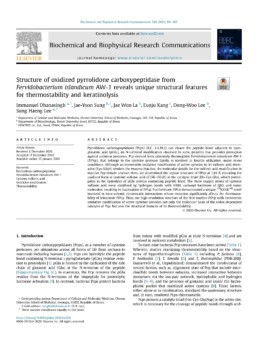Structure of oxidized pyrrolidone carboxypeptidase from Fervidobacterium islandicum AW-1 reveals unique structural features for thermostability and keratinolysis
Abstract
Pyrrolidone carboxypeptidases (Pcps) (E.C. 3.4.19.3) can cleave the peptide bond adjacent to pyro-glutamic acid (pGlu), an N-terminal modification observed in some proteins that provides protection against common proteases. Pcp derived from extremely thermophilic Fervidobacterium islandicum AW-1 (FiPcp), that belongs to the cysteine protease family, is involved in keratin utilization under stress conditions. Although an irreversible oxidative modification of active cysteine to its sulfonic acid derivative (Cys-SO3H) renders the enzyme inactive, the molecular details for the sulfonic acid modification in inactive Pcp remain unclear. Here, we determined the crystal structure of FiPcp at 1.85 Å, revealing the oxidized form of cysteine sulfonic acid (C156–SO3H) in the catalytic triad (His-Cys-Glu), which participates in the hydrolysis of pGlu residue containing peptide bond. The three oxygen atoms of cysteine sulfonic acid were stabilized by hydrogen bonds with H180, carbonyl backbone of Q83, and water molecules, resulting in inactivation of FiPcp. Furthermore, FiPcp demonstrated a unique 139KKKK142 motif involved in inter-subunit electrostatic interactions whose mutation significantly affects the thermostability of tetrameric FiPcp. Thus, our high-resolution structure of the first inactive FiPcp with irreversible oxidative modification of active cysteine provides not only the molecular basis of the redox-dependent catalysis of Pcp, but also the structural features of its thermostability.
CategoryPeer-reviewed PublicationsDate2020.12Linkwww.sciencedirect.com
